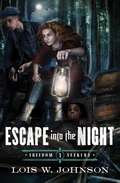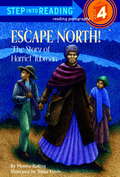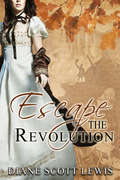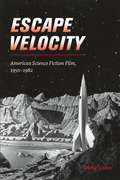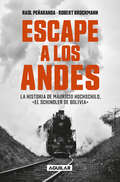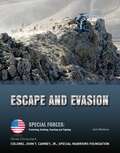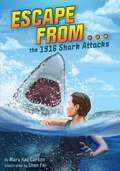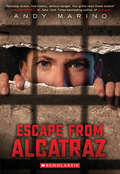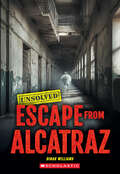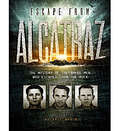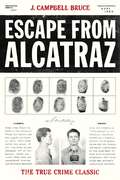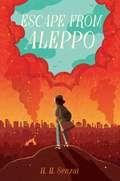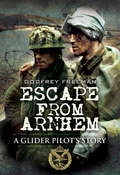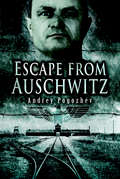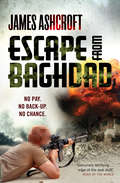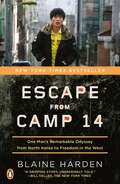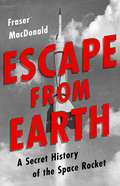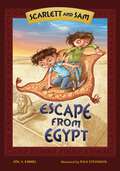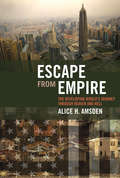- Table View
- List View
Escape From the Soviets
by Tatiana TchernavinEscape From the Soviets by Tatiana Tchernavin is a gripping and deeply personal memoir of survival, resilience, and courage during one of the darkest periods in Soviet history. Written with raw honesty and vivid detail, the book chronicles Tatiana and her husband Vladimir’s harrowing journey to escape the oppressive Soviet regime in the early 1930s.Tatiana recounts the couple’s experiences as they faced constant surveillance, political persecution, and the brutal realities of life under Stalin’s rule. Vladimir, a fisheries expert, becomes a target of the Soviet government’s purges, forcing the couple to make the perilous decision to flee the country. Their journey takes them through treacherous landscapes, from the frozen tundra to dense forests, as they navigate hostile terrain, evade capture, and confront the physical and emotional toll of their flight.This memoir is not only a thrilling tale of escape but also a poignant commentary on the human spirit’s ability to endure and overcome unimaginable adversity. Through Tatiana’s eyes, readers gain a firsthand perspective on the Soviet regime’s impact on individual lives, families, and communities, as well as the suffocating atmosphere of fear and repression that defined the era.Rich with suspense, heartache, and moments of hope, Escape From the Soviets offers a rare and invaluable glimpse into a world of oppression and resistance. Tatiana Tchernavin’s story stands as a testament to the strength of love, loyalty, and the indomitable will to be free.This powerful memoir is an essential read for those interested in Soviet history, personal narratives of resistance, and the enduring fight for liberty.
Escape In Italy; The Narrative Of Lieutenant William L. Newnan
by Lt. William L. NewnanDuring the bloody fighting of the Second World War the hills, river valleys and hellish attrition of the Italian campaign are often overlooked as a sideshow. However some of the toughest fighting and heroic actions of the entire period took place in the beautiful but deadly Italian countryside; one such tale is that of Lt. Newnan. Then as now, the Army Rangers get the toughest assignments, Lt. Newnan and his men were tasked with attacking Cisterna during the Anzio campaign. The elite, but lightly armed, Rangers were ambushed by German Panzer forces, outnumbered and outgunned many Rangers were captured including the author. Not one to be so easily defeated Lt. Newnan began an epic journey of escape and evasion in Nazi infested Italy which he recounts in this vivid and colorful memoir.
Escape Into The Night (Freedom Seekers #1)
by Lois W. Johnson"I want a never-give-up family," Libby Norstad tells her widowed father, captain of the steamboat Christina. "I want a family that believes in me, even when I'm not perfect. A family that sticks together, even though it's hard. " "We can be that family for each other," Pa promises. "And Caleb and the other people who work on the Christina will be our larger family. " But Libby has lived with a wealthy aunt since her mother died and discovers a different world. In 1857, when rivers were the highways of the time, Libby, her father, and their friends face life-and-death questions still crucial today: Who can I trust? What does it mean to put my faith in God? To live my belief in the freedoms sought in the Declaration of Independence? And how can I help others, even at great cost? Soon Libby discovers the secret work of 14-year-old Caleb, a conductor in the Underground Railroad. Next, a fugitive slave named Jordan takes refuge on the Christina. Then another family, Emma and little Henry, pushes toward a choice. Will her journey to compassion help her become a Freedom Seeker? From the golden age of steamboats, the rush of immigrants to new land, and the dangers of the Underground Railroad come true-to-life stories of courage, integrity, and suspense. In Escape into the Night, the first Freedom Seekers novel, as well as others in the 1857 series, Lois Walfrid Johnson uses strong historical interest to bring alive a critical time in American history. The Freedom Seekers series is a six-novel middle-reader set in 1857. Feel the rush of immigrants to the new land, and the dangers of the Underground Railroad in these true-to-life Riverboat stories. The characters will receive a heart-warming response from readers of all ages. Adult readers will ask themselves, "Would I have been one of those who helped runaway slaves?" Lois Walfrid Johnson uses strong historical research, great writing, and wonderful storytelling to bring alive a critical time in American history.
Escape North! The Story of Harriet Tubman: The Story Of Harriet Tubman (Step into Reading)
by Monica Kulling Teresa FlavinAn easy-to-read, page-turning account of Harriet Tubman's life--from her childhood in slavery to her years as a conductor on the Underground Railroad to her later work as a suffragette and as a spy in the Civil War. This remarkable true story brings to life one of America's greatest female role models.
Escape The Revolution
by Diane Scott LewisForced from France by her devious guardian on the eve of the French Revolution, Countess Bettina Jonquiere must deliver an important package to further the royalist cause. In England, she discovers the package is full of blank papers, the address false and she’s penniless. Stranded in a Cornish village, Bettina toils in a bawdy tavern and falls in love with a man who may have murdered his unfaithful wife. Tracked by ruthless revolutionaries, she must uncover the truth about her father’s murder—and her lover’s guilt—while her life is threatened.
Escape To Liechtenstein (Young Refugees #1)
by Ed DunlopEscape to Liechtenstein by Ed Dunlop is a historical fiction account of Hans and his sister Gretchen who discover a young Jewish boy hiding from Nazi troops. While all three children know that Jacob will not be safe until he crosses over the Austrian border, Hans and Gretchen have no idea that Jacob is also smuggling something even more important that is valuable to him, to the Jewish people, and to the enemy. Escape to Liechtenstein is the first book in the Young Refugees Series that is Christian fiction set in Europe during WWII.
Escape Velocity: American Science Fiction Film, 1950–1982 (Wesleyan Film Ser.)
by Bradley SchauerToday, movie theaters are packed with audiences of all ages marveling to exciting science fiction blockbusters, many of which are also critically acclaimed. However, when the science fiction film genre first emerged in the 1950s, it was represented largely by exploitation horror films—lurid, culturally disreputable, and appealing to a niche audience of children and sci-fi buffs. How did the genre evolve from B-movie to blockbuster? Escape Velocity charts the historical trajectory of American science fiction cinema, explaining how the genre transitioned from eerie low-budget horror like It Came from Outer Space to art films like Slaughterhouse-Five, and finally to the extraordinary popularity of hits like E.T. Bradley Schauer draws on primary sources such as internal studio documents, promotional materials, and film reviews to explain the process of cultural, aesthetic, and economic legitimation that occurred between the 1950s and 1980s, as pulp science fiction tropes were adapted to suit the tastes of mainstream audiences. Considering the inescapable dominance of today’s effects-driven blockbusters, Escape Velocity not only charts the history of science fiction film, but also gives an account of the origins of contemporary Hollywood.
Escape a los Andes
by Raúl Peñaranda Robert BrockmannLa desconocida historia del “Schindler de Bolivia”, que salvó de morir en el Holocausto a miles de refugiados judíos. Mauricio Hochschild fue un empresario minero de origen judío alemán y uno de los hombres más acaudalados de su tiempo en América. Su sede central estuvo en Chile, la fuente de su riqueza en Bolivia y abrió oficinas en Perú y Argentina, cuya nacionalidad adoptó después de perder la alemana en 1933 a causa del nazismo. Gracias a él, que movió recursos y su influencia política, cerca de veinte mil judíos provenientes de Alemania, Austria y Polonia, Checoslovaquia, Hungría e Italia llegaron a Bolivia desde fines de los años treinta. A través de una serie de documentos de reciente descubrimiento, de múltiples entrevistas y una acuciosa investigación, los autores —destacados periodistas— han podido reconstruir no solo los esfuerzos de Hochschild por salvar al mayor número posible de judíos, sino también examinar sus enormes habilidades, las críticas que debió enfrentar, las denuncias de que fue un explotador, el peligro de muerte que soportó debido a los tiempos volátiles y revolucionarios en Bolivia, y no menos importante, su extraordinaria y compleja vida amorosa y familiar.
Escape and Evasion (Special Forces: Protecting, Building, Te)
by Jack MontanaOperating behind enemy lines takes nerve, courage, and skill. Above all, it requires the knowledge of how to stay undetected and how to escape if need be. These are the lessons of Escape and Evasion. The book covers all the essential skills of an undercover soldier. Infiltration by land, sea, and air are described in detail. The unique physical demands of night fighting are explained. Tracking techniques are also revealed, showing how the elite soldier can tell where the enemy is from broken twigs and dropped litter. In addition, this book explains some of the most surprising features of behind-the-lines operations, including: * How you can fool a tracker dog * Why you should look at the outline of shapes at night. * How you can calculate the distance of an enemy from a gunshot. * Why you should put bits of tape on all metal objects you carry. * What the best place is for an ambush.
Escape de los Balcanes: La admirable saga de la familia Konforti durante el Holocausto
by Dinah Spitalnik Alicia EscardóRecreada con la intensidad de una novela, esta asombrosa crónica está bordada de aromas, sabores y costumbres que acompañan a esta familia en su peripecia entre la guerra y la dignidad humana. Dos mujeres narran como en torrente aquellos años de incertidumbres y miedo. Una menciona truenos en la noche. La otra le dice que eran disparos de metralleta. Hablan de aquella familia musulmana que los auxilió, del peso de las monedas cosidas en la ropa interior y del aire gélido de las montañas que debieron atravesar para escapar. Pasaron más de setenta años del holocausto en los Balcanes y Dinah escucha asombrada esta conversación entre su madre y tía abuela. Empieza a entender tantas cosas, a unir recuerdos, a evocar el aroma de las recetas de la abuela y comprender que fueron su silenciosa forma de rememorar# Tiempo después, un inesperado correo disparará definitivamente su búsqueda, con el objetivo de completar el legado. Escape de los Balcanes recoge el viaje de descubrimiento que emprende Dinah por Macedonia, Kosovo y Albania, rutas por las que su familia deambuló para sobrevivir, y las vivencias de los Konforti entre 1940 y 1944, cuando empiezan las persecuciones a los judíos. Recreada con la intensidad de una novela, esta asombrosa crónica está bordada de aromas, sabores y costumbres que acompañan a esta familia en su peripecia entre la guerra y la dignidad humana.
Escape from . . . the 1916 Shark Attacks (Escape From . . .)
by Mary Kay CarsonStay out of the water! During the summer of 1916, the "Jersey man-eater"-a great white shark-terrorized the coast of New Jersey. Based on real events, new friends Ed and Mike have to work together to survive one of the deadliest shark attacks in history!In the blistering summer of 1916, Ed Mitchell is melting in the heat wave boiling New York City. All the city pools are closed because of the polio epidemic, so Ed can't wait to flee to the Jersey Shore and cool off in the ocean. But during his first dip, a great white shark attacks a swimmer and sends the coastline into a panic. Ed is sent away from the shore to visit his aunt in Matawan, New Jersey, where he can stay safe and cool.In Matawan, Ed meets Mike Anders-a local boy who knows all the best spots in the nearby creek. Mike vows to teach Ed to swim, and Ed promises to help Mike read better. Little do they know, the new friends are about to have the summer of their lives.The "Jersey man-eater," the dangerous shark who keeps attacking swimmers, is headed right up the coast and into their favorite swimming spot! Will Ed and Mike be able to survive one of the deadliest shark attacks in history?
Escape from Alcatraz (Escape From)
by Andy Marino"Nonstop action, real history, serious danger. You gotta read these books!" -Alan Gratz, #1 New York Times bestselling author of RefugeeMay 1962In the middle of San Francisco Bay looms Alcatraz, home to America’s most infamous prisoners. Also home to Chip Carter and his dad, who works at the high security prison. Their neighbors are former mobsters, gangsters, and murderers, but Chip finds it to be a pretty boring place to live. After all, the inmates can’t hurt him--they’re locked up in an impenetrable fortress, surrounded by unforgiving waters.Or are they?Inmate AZ1441, aka the Watcher, has a plan to break out of Alcatraz. It’s a genius plan he’s concocted along with three other inmates. Foolproof. Or so he thought until one of the guard’s kids stumbles into the middle of it.Chip is stunned. No one can break out of the Rock. Not unless they have an inside guy. Which it seems like they do ... Chip’s dad. They know Chip’s onto them, so if he wants to survive, he’s going to have to make sure these men stay locked up. But first he has to figure out who is planning the prison break and just how deep into this deadly scheme his dad is. Because given what these men have done to end up in Alcatraz, there’s no telling what they’ll do to get out.
Escape from Alcatraz (Unsolved)
by Dinah WilliamsDid any prisoners ever escape Alcatraz? Discover the unsolved mystery in this beautifully illustrated book for kids, accessible for all readers!Alcatraz, once the world's most secure prison, is located on a small island in San Francisco Bay. Throughout its operation, many attempted to escape. In June 1962, three prisoners managed to break out, but they were never heard from again. What happened to them?Discover this unsolved mystery with real clues, facts, and pictures in the pages of this book. The story will unfold with easy-to-read text and exciting visuals. You can decide for yourself what you think happened during this mysterious escape from Alcatraz!ABOUT THIS SERIES:Take a deep dive into some of the most unbelievable but real unsolved mysteries from history. Is the Bermuda Triangle cursed? Do sea monsters exist? Can people just disappear? Each book in this series focuses on one unsolved mystery and describes its main events chronologically. Readers follow along as the exciting narrative uncovers real historical clues. Multiple theories are presented, providing an opportunity for readers to draw their own conclusions. The most up-to-date facts and relevant modern-day discoveries are included to allow for real-world connections. Perhaps you will be the one to solve an unsolved mystery!
Escape from Alcatraz: The Mystery of the Three Men Who Escaped from the Rock
by Eric BraunA 1962 prison break from the notorious island prison in San Francisco Bay will hold readers captive as they consider fact and fiction.
Escape from Alcatraz: The True Crime Classic
by J. Campbell BruceIn 1963, just weeks before the original publication of this book, the last prisoner was escorted off Devil's Island and Alcatraz ceased to be a prison. Author J. Campbell Bruce chronicles in spellbinding detail the Rock's transition from a Spanish fort to the maximum-security penitentiary that housed such infamous inmates as Robert Stroud, aka the Birdman of Alcatraz, and mobster Al "Scarface" Capone. The chapters describing the daring escape attempts by Frank Morris and two accomplices from this "inescapable" prison became the basis for the 1979 Clint Eastwood movie. Discover the intriguing and absorbing saga of Alcatraz, whose name is still synonymous with punitive isolation and deprivation, where America's most violent and notorious prisoners resided in tortuous proximity to one of the world's favorite cities.The true-crime classic first published in 1963 is reissued in this special edition.Includes archival photos of the prison and prison life.This story will appeal to Bay Area locals and tourists alike.Alcatraz hosts more than a million visitors each year.From the Trade Paperback edition.
Escape from Aleppo
by N. H. SenzaiAn Indie Next List Pick <p><p> Nadia’s family is forced to flee their home in Aleppo, Syria, when the Arab Spring sparks a civil war in this timely coming-of-age novel from award-winning author N.H. Senzai.Silver and gold balloons. <p><i>A birthday cake covered in pink roses. A new dress. </i> <p>Nadia stands at the center of attention in her parents’ elegant dining room. This is the best day of my life, she thinks. Everyone is about to sing “Happy Birthday,” when her uncle calls from the living room, “Baba, brothers, you need to see this.” Reluctantly, she follows her family into the other room. On TV, a reporter stands near an overturned vegetable cart on a dusty street. Beside it is a mound of smoldering ashes. The reporter explains that a vegetable vendor in the city of Tunis burned himself alive, protesting corrupt government officials who have been harassing his business. Nadia frowns. <p> It is December 17, 2010: Nadia’s twelfth birthday and the beginning of the Arab Spring. Soon anti-government protests erupt across the Middle East and, one by one, countries are thrown into turmoil. As civil war flares in Syria and bombs fall across Nadia’s home city of Aleppo, her family decides to flee to safety. Inspired by current events, this novel sheds light on the complicated situation in Syria that has led to an international refugee crisis, and tells the story of one girl’s journey to safety.
Escape from Arnhem: A Glider Pilot’s Story
by Godfrey FreemanThis is the remarkable true story of a young army glider pilots experience of the last days in the defense of Arnhem Bridge, his eventual capture and then escape to be adopted by the Resistance, the hair-raising journey through occupied Europe and his eventual return to the UK. After capture Freeman was first taken to Apeldoorn where he was hospitalized, claiming shell-shock. Although quite sane, he feigned trauma with escape in mind, until being punished for aiding the escape of four Allied inmates. Then he was put on a train bound for Germany, from this he escaped and eventually made contact with the Dutch underground. He is given civilian cloths and a bicycle and rides overnight to Barnveld where he stays with a schoolmaster and church organist. Then another cycle ride to a farm where he sleeps in the hayloft and finally still on his bike, he rides through the German front lines. He eventually is returned to RAF Broadwell by Dakota to resume his part in the war, from capture to freedom within a month. The text is interspersed with flashbacks to the authors childhood and early training, capturing the true spirit of a typical modest and yet outstandingly brave young man of the wartime era.
Escape from Auschwitz
by Andrey PogozhevThis memoir of a Soviet POW&’s escape from a Nazi concentration camp is a remarkable account of cruelty and courage during WWII. On November 6, 1942, seventy Soviet prisoners of war staged an extraordinary mass escape from Auschwitz. Among the escapees was prisoner number 1418, Andrey Pogozhev. One of the few who managed to evade the pursuing Nazi guards, Pogozhev lived to tell his story in this singular chronicle of wartime survival. Pogozhev was caught by the Germans in 1941 and immediately sent to Auschwitz. He and his Red Army comrades were then put to work on the Birkenau construction site. Sick, starving, and forced to work in sub-zero weather, more than three hundred Russian prisoners died in a single day. Pogohzev vividly recounts what life was like inside Auschwitz, how a group of prisoners managed to organize and execute one of the few successful escapes from Auschwitz, and his punishing journey as a fugitive fleeing through the Carpathian Mountains into the Ukraine.
Escape from Baghdad: First Time Was For the Money, This Time It's Personal
by James AshcroftGun-for-hire James 'Ash' Ashcroft thought he'd left Iraq behind. Last time he only got out alive thanks to the bravery of his interpreter and friend Sammy. But now a call for help means Ash must once again face the chaos of war-torn Baghdad - and this time there's no pay cheque. Abandoned by the occupying Coalition Forces, Sammy and his family face certain death at the hands of the Shia-dominated Iraqi Police and the death squads that roam the streets unless Ash and his team can get in and get them to safety over the border. This is the action-packed story of their audacious escape from Baghdad. It is a gripping account of the chaos of war, where the only thing that can be relied upon is the bond between former brothers-in-arms.
Escape from Berlin
by Irene N. WattsGood-bye Marianne - As autumn turns toward winter in 1938 Berlin, life for Marianne Kohn, a young Jewish girl, begins to crumble. First there was the burning of the neighborhood shops. Then her father, a bookseller, must leave the family and go into hiding. No longer allowed to go to school or even sit in a café, Marianne's only comfort is her beloved mother. Remember Me - Young Marianne is one of the lucky ones. She has escaped on the first Kindertransport organized to take Jewish children out of Germany to safety in Britain. At first Marianne is desperate. Marianne speaks little English and is made to feel unwelcomed in her sponsor's home and, most of all, she misses her mother terribly. As the months pass, she realizes that she cannot control the circumstances around her. She must rely on herself if she is to survive. Finding Sophie - Sophie Mandel was only seven years old when she arrived in London on the first Kindertransport from Germany. She has grown up with a friend of her parents, a woman she calls Aunt Em, and despite the war and its deprivations, she has made a good life for herself in England with her foster mother. She has even stopped thinking about the parents she left behind. Now the war is over, and fourteen-year-old Sophie is faced with a terrible dilemma. Where does she belong?
Escape from Camp 14: One Man's Remarkable Odyssey from North Korea to Freedom in the West
by Blaine Harden&“If you have a soul, you will be changed forever by Blaine Harden&’s Escape from Camp 14." —Mitchell Zuckoff, New York Times bestselling author of Lost in Shangri-LaThe heartwrenching New York Times bestseller about the only known person born inside a North Korean prison camp to have escaped North Korea&’s political prison camps have existed twice as long as Stalin&’s Soviet gulags and twelve times as long as the Nazi concentration camps. No one born and raised in these camps is known to have escaped. No one, that is, except Shin Dong-hyuk.In Escape From Camp 14, Blaine Harden unlocks the secrets of the world&’s most repressive totalitarian state through the story of Shin&’s shocking imprisonment and his astounding getaway. Shin knew nothing of civilized existence—he saw his mother as a competitor for food, guards raised him to be a snitch, and he witnessed the execution of his mother and brother.The late &“Dear Leader&” Kim Jong Il was recognized throughout the world, but his country remains sealed as his third son and chosen heir, Kim Jong Eun, consolidates power. Few foreigners are allowed in, and few North Koreans are able to leave. North Korea is hungry, bankrupt, and armed with nuclear weapons. It is also a human rights catastrophe. Between 150,000 and 200,000 people work as slaves in its political prison camps. These camps are clearly visible in satellite photographs, yet North Korea&’s government denies they exist.Harden&’s harrowing narrative exposes this hidden dystopia, focusing on an extraordinary young man who came of age inside the highest security prison in the highest security state. Escape from Camp 14 offers an unequalled inside account of one of the world&’s darkest nations. It is a tale of endurance and courage, survival and hope.
Escape from Earth: A Secret History of the Space Rocket
by Fraser MacDonaldThe long-buried truth about the dawn of the Space Age: lies, spies, socialism, and sex magick.Los Angeles, 1930s: Everyone knows that rockets are just toys, the stuff of cranks and pulp magazines. Nevertheless, an earnest engineering student named Frank Malina sets out to prove the doubters wrong. With the help of his friend Jack Parsons, a grandiose and occult-obsessed explosives enthusiast, Malina embarks on a journey that takes him from junk yards and desert lots to the heights of the military-industrial complex.Malina designs the first American rocket to reach space and establishes the Jet Propulsion Laboratory. But trouble soon finds him: the FBI suspects Malina of being a communist. And when some classified documents go missing, will his comrades prove as dependable as his engineering?Drawing on an astonishing array of untapped sources, including FBI documents and private archives, Escape From Earth tells the inspiring true story of Malina's achievements--and the political fear that's kept them hidden. At its heart, this is an Icarus tale: a real life fable about the miracle of human ingenuity and the frailty of dreams.
Escape from East Berlin
by Andy MarinoFrom the author of The Plot to Kill Hitler trilogy and Escape from Chernobyl comes another fast-paced, high-interest historical thriller, chronicling two daring attempts to cross the Berlin Wall, set decades apart.December, 1961 - Marta is a young girl who saw thirty miles of barbed wire appear across her city overnight, separating Berlin into West and East — with Marta’s home on the Communist Bloc-controlled eastern side.--January, 1989 - Now a spray-painted concrete monolith, the Berlin Wall bisects the city. Kurt, a young East Berliner, often wonders what those living on the other side must think of their unseen neighbors. Do they hate the people of East Germany as completely as Kurt has been instructed to hate them?--Inspired by real events, Escape from East Berlin tells two stories of daring bids for freedom from the Eastern Bloc, set decades apart and relayed in alternating perspectives. Triumph and tragedy intertwine in this examination of both the earliest and final days of the Berlin Wall.
Escape from Egypt: Escape From Egypt (Scarlett and Sam)
by Eric A. KimmelOne minute, twins Scarlett and Sam are bickering about who's going to read the Four Questions at the Passover seder. The next minute, they've been swept up by Grandma Mina's time-traveling carpet and dumped in the ancient Egyptian desert! And as if being stranded 3,000 years in the past isn't bad enough, they also find their fellow Hebrews suffering in slavery. So they team up with Moses, Aaron, and Miriam to help free the slaves. The future's looking bright! But the story they know so well doesn’t turn out the way they expected...
Escape from Empire: The Developing World's Journey through Heaven and Hell
by Alice H. AmsdenA provocative view of economic growth in the Third World argues that the countries that have achieved steady economic growth—including future economic superpowers India and China—have done so because they have resisted the American ideology of free markets. The American government has been both miracle worker and villain in the developing world. From the end of World War II until the 1980s poor countries, including many in Africa and the Middle East, enjoyed a modicum of economic growth. New industries mushroomed and skilled jobs multiplied, thanks in part to flexible American policies that showed an awareness of the diversity of Third World countries and an appreciation for their long-standing knowledge about how their own economies worked. Then during the Reagan era, American policy changed. The definition of laissez-faire shifted from "Do it your way," to an imperial "Do it our way." Growth in the developing world slowed, income inequalities skyrocketed, and financial crises raged. Only East Asian economies resisted the strict prescriptions of Washington and continued to boom. Why? In Escape from Empire, Alice Amsden argues provocatively that the more freedom a developing country has to determine its own policies, the faster its economy will grow. America's recent inflexibility—as it has single-mindedly imposed the same rules, laws, and institutions on all developing economies under its influence—has been the backdrop to the rise of two new giants, China and India, who have built economic power in their own way. Amsden describes the two eras in America's relationship with the developing world as "Heaven" and "Hell"—a beneficent and politically savvy empire followed by a dictatorial, ideology-driven one. What will the next American empire learn from the failure of the last? Amsden argues convincingly that the world—and the United States—will be infinitely better off if new centers of power are met with sensible policies rather than hard-knuckled ideologies. But, she asks, can it be done?


